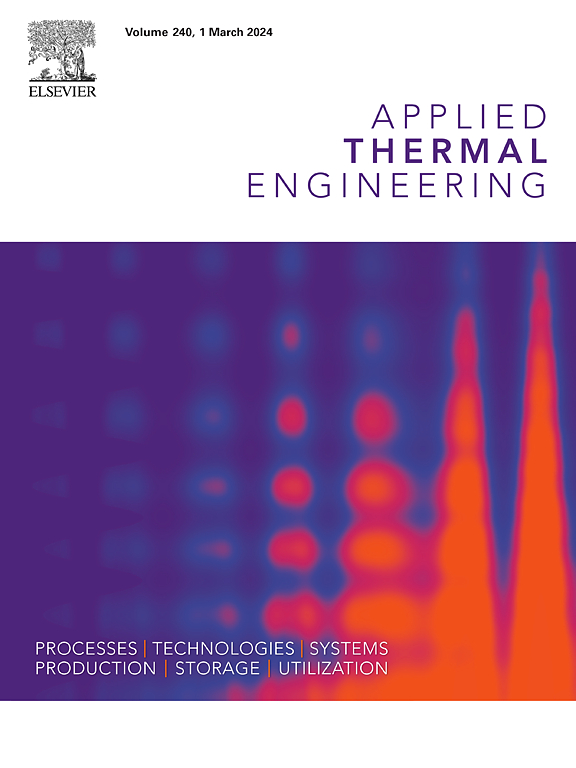Performance analysis of a wet pad assisted air-cooled battery thermal management system with varying number of battery cells
IF 6.1
2区 工程技术
Q2 ENERGY & FUELS
引用次数: 0
Abstract
Battery thermal management system is essential in electric vehicles to ensure thermal safety and efficient battery operation. Air-cooled battery thermal management technology is well-developed and inexpensive, but the small convection coefficient of air limits the heat dissipation capability of the system. Direct evaporative cooling, in the form of a wet pad, can be integrated to enlarge the cooling capacity through water evaporation. There is little research investigating the effectiveness of the system under varying number of battery cells. Besides, the minimum temperature of the battery pack is rarely discussed under various ambient conditions. Different from previous work, this paper aims to indicate the optimal working condition zones of a wet pad assisted air-cooled battery thermal management system. Thermal model of the wet pad and battery pack are established using MATLAB and Fluent software, respectively. Simulation results show that with the assistance of the wet pad, 4.9–6.2 °C cooler air would be produced, resulting in a 3.6–6.1 °C reduction in the maximum surface temperature of the battery but a slightly larger temperature difference among batteries. Better cooling performance of the wet pad can be obtained at arid ambient conditions. Using the wet pad, the optimal working condition zones of the battery pack are expanded because it is more capable of hot weather. Battery temperature control failed in the dry-air cooling cases at 2C discharge rate with 18 batteries and above, but with the wet pad, it can be controlled at 33.6 °C even with 60 batteries. Lastly, from an optimization viewpoint, by wrapping each battery with 0.5 mm aluminum flake, the maximum surface temperature and the temperature difference of the battery pack can be reduced by 4.1 % and 17.4 %, respectively. The findings will be beneficial for the design and optimization of a wet pad assisted air-cooled battery thermal management system.
不同电池单元数量的湿垫辅助风冷电池热管理系统性能分析
电池热管理系统在电动汽车中至关重要,可确保热安全和电池的高效运行。风冷电池热管理技术已经发展成熟且成本低廉,但由于空气的对流系数较小,限制了系统的散热能力。可以集成湿垫形式的直接蒸发冷却,通过水蒸发扩大冷却能力。目前很少有研究调查该系统在不同电池数量下的有效性。此外,关于电池组在各种环境条件下的最低温度的讨论也很少。与以往的研究不同,本文旨在指出湿垫辅助风冷电池热管理系统的最佳工作条件区。本文分别使用 MATLAB 和 Fluent 软件建立了湿垫和电池组的热模型。仿真结果表明,在湿垫的辅助下,可产生 4.9-6.2 °C的低温空气,从而使电池的最高表面温度降低 3.6-6.1 °C,但电池之间的温差略大。在干旱的环境条件下,湿垫可以获得更好的冷却性能。使用湿垫后,电池组的最佳工作条件区扩大了,因为它更能适应炎热的天气。在干空气冷却情况下,电池组温度控制在 18 节电池及以上,放电率为 2 摄氏度时就会失效,而使用湿垫后,即使有 60 节电池,电池组温度也能控制在 33.6 摄氏度。最后,从优化的角度来看,用 0.5 毫米的铝片包裹每块电池,电池组的最高表面温度和温差可分别降低 4.1% 和 17.4%。这些发现将有助于湿垫辅助风冷电池热管理系统的设计和优化。
本文章由计算机程序翻译,如有差异,请以英文原文为准。
求助全文
约1分钟内获得全文
求助全文
来源期刊

Applied Thermal Engineering
工程技术-工程:机械
CiteScore
11.30
自引率
15.60%
发文量
1474
审稿时长
57 days
期刊介绍:
Applied Thermal Engineering disseminates novel research related to the design, development and demonstration of components, devices, equipment, technologies and systems involving thermal processes for the production, storage, utilization and conservation of energy, with a focus on engineering application.
The journal publishes high-quality and high-impact Original Research Articles, Review Articles, Short Communications and Letters to the Editor on cutting-edge innovations in research, and recent advances or issues of interest to the thermal engineering community.
 求助内容:
求助内容: 应助结果提醒方式:
应助结果提醒方式:


